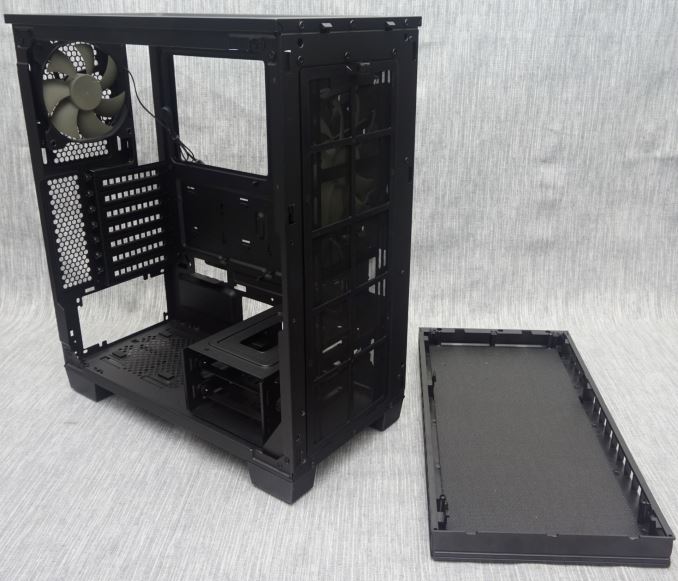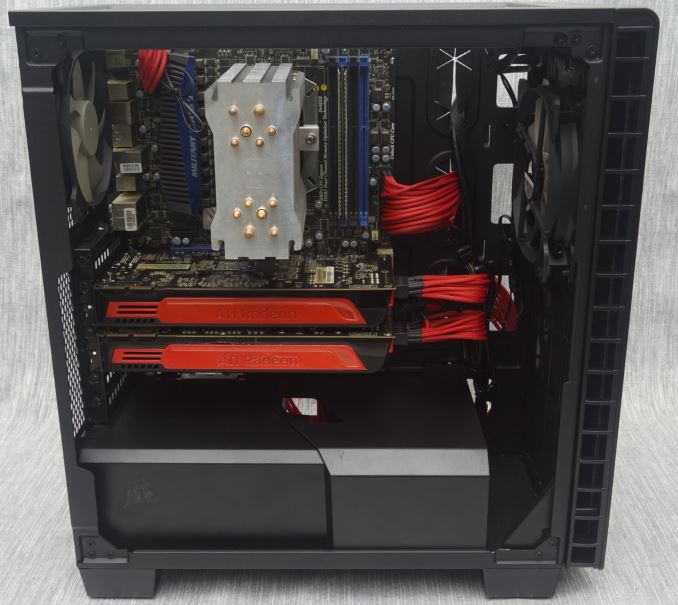The Corsair Carbide 400Q Case Review
by E. Fylladitakis on April 29, 2016 9:00 AM EST- Posted in
- Cases/Cooling/PSUs
- Corsair
- ATX
- E-ATX
- Carbide
Conclusion
With the Carbide 400Q, Corsair wanted to create a compact and elegant case that also offers good thermal performance and very low noise levels, all for a reasonable price tag. These are just too many eggs for one basket and a single design cannot possibly excel on all five of those areas. It is the balance between them that matters and we feel that Corsair did a fine job balancing their design to the best possible extent.
The Carbide 400Q is one of the most compact cases currently available that can support an Extended ATX motherboard, as well as top tier graphics cards and liquid cooling systems. It cannot support many drives but these are more than enough for the majority of home and office users, most of which own a maximum of two or three drives. There is no support for external drives, forcing users who want to work with optical media to go for an external device. This can be a problem for professionals, especially for those that need to receive or share digital material with their customers. Most home users and gamers will not mind, as the bulk of digital material is being transferred online nowadays.
In terms of quality, the Carbide 400Q is very good overall. The mechanical strength of the steel chassis is excellent. It is next to impossible to bent or twist the chassis, even if a lot of force is applied. The paint job is excellent, highly resistant to fingerprints and scratching. Our only concern lies with the plastic frame of the faceplate. The plastics are thick and of very good quality, but it is very tightly attached to the metallic frame of the case, requiring a lot of force to remove it.
With the stock configuration in mind, the balance between thermal performance and acoustics is towards the latter, but the Carbide 400Q still offers thermal performance comparable to that of most ATX tower cases and can easily support a relatively powerful system. If the user wants to, the Carbide 400Q can support even systems with triple graphics cards and liquid cooling, but that would require the removal of the top panel cover and the installation of more and more powerful fans. This would defeat the purpose of buying the Carbide 400Q in the first place, as the end result would probably be a cramped, noisy setup.
In conclusion, the Carbide 400Q is finely balanced between thermal performance, size and acoustics. It currently retails at it MSRP price of $99, which is reasonable for such a case but, in our opinion, if it could have been a little lower it would be more competitive in a crowded market. Nevertheless, the Carbide 400Q can be a very good choice for a typical gaming PC, allowing for relatively low noise levels and good thermal performance using the stock configuration with the case fan thermally controlled by the motherboard.












63 Comments
View All Comments
niva - Friday, April 29, 2016 - link
My Antec TITAN 650 is still in use, I don't think I'll ever need/want another case for a workstation... but yeah, it does make my back hurt thinking about it :)kmmatney - Friday, April 29, 2016 - link
I am still using my P182 from 2007. I'm been wanting to replace it for the last 4 years, but always spend the money on cpu or video card upgrades instead. I clean and oil the fans 3 years or so, and still have the originals. About the only thing that wears out on a case (besides the fans) are the front USB ports, and mine barely work. There are no 2.5" drive mounts, so my 2 SSDs are mounted with tie straps. It's big and heavy, but virtually silent, and keeps everything cool. I hate the stupid divider between the motherboard and PSU compartments, but other than that it's still a nice case. I've always felt monitors and cases are worth spending a little extra on, as they can last so long.Valantar - Sunday, May 1, 2016 - link
What happened to Antec, really? Ten years ago, they were the bee's knees when it came to stylish, quiet, high-performing cases. These days, they're hardly relevant at all. I remember when the Fractal Define R3(?) first came to market, and everyone was raving that "it's a P180 for half the price!" Did Antec's R&D department die of shock? The P280 looks half decent, but it's huge and unwieldy, and has some odd solutions. The P183 looks like it was designed in 2005, and is hideous compared to the P180. Don't even mention the P193. And their other cases? Blergh.Jeff7181 - Friday, April 29, 2016 - link
No external 5.25 inch bays? Really? Optical media is not THAT dead...jardows2 - Friday, April 29, 2016 - link
I would think without the 5.25 bays, it could have been designed a bit smaller. Wouldn't fit EATX that way, but not sure there is a big market for enthusiast EATX motherboards and compact cases like this.Black Obsidian - Friday, April 29, 2016 - link
There isn't really much space to be saved without sacrificing other use cases. Making the case less tall or less wide isn't really possible, as there's already no slack room to speak of. Reducing depth by more than 1" means sacrificing front-mounted radiators, long video cards, or both.Compared to, say, the Corsair 450D, the 400Q already trims 2.8" of height and 1.3" of depth. It's 0.2" wider, but that's just as well, given that the 450D was a bit tight on space for cables behind the motherboard tray.
Realistically, if you want a smaller case, you'll have to accept the mATX form-factor, with the trade-offs that entails.
jardows2 - Friday, April 29, 2016 - link
Even with mATX, it seems that any case forgoing the 5.25 drives do not make use of that deletion to save space. The cases either have the 5.25 drive bays, or might as well due to the size. It isn't until you get to mITX sized cases that the space savings gets fully realized, and even then, there are some rather large mITX cases.Black Obsidian - Friday, April 29, 2016 - link
You *are* saving space by forgoing the 5.25" drives, though. Look at my comparison above; the 450D has 2x 5.25" bays, which together are 3.2" tall. The 400Q omits those, and is 2.8" shorter. There's literally no more space to be saved, because the interior height is the sum of ATX PSU + ATX motherboard + 25mm top fan.To get any smaller while still supporting the same basic component set would require Time Lord science.
jardows2 - Friday, April 29, 2016 - link
I compare this to my NZXT Source 210 case, which, I know, is a budget case. This Corsair is taller and wider than my case by about an inch each way (height difference may be simply the large feet of the 400Q). It is about 3" less in depth. For that mere 3" of depth, I lose 3 5.25" external bays, and 3 internal 3.5" bays. I would think that it would be possible to make an even more compact ATX case than the 400Q with the elimination of the 5.25" bays.Ninhalem - Friday, April 29, 2016 - link
Grab an external optical drive if you need one that badly, or go for some of the higher end carbide or obsidian series for the 5.25" bay. Media consumption is almost exclusively streaming now.